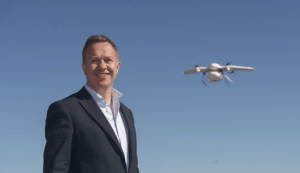
In September, DroneLife reported on the world’s first BVLOS medical delivery in Ireland.
Researchers at NUI Galway partnered with German drone startup Wingcopter to transport prescription medication and blood samples for diabetes patients.
This week, the research team released more details about the project in an ENDO 2020 abstract to be published in the Journal of the Endocrine Society.
The 16-minute test flight from Galway, Ireland, to the Aran Islands – about 12 miles off the west Irish coast – required approvals from aviation, pharmaceutical and clinical regulatory agencies.
Because severe storms have disrupted healthcare access in Ireland over the past few years, the team sought a solution to deliver vital medicine, like insulin, to diabetes patients in remote regions. Patients might otherwise be stranded for days without treatment.
“We now have the drone technology and protocols in place to deliver diabetes medications and supplies in an actual disaster if needed,” project lead Derek O’Keeffe said. “This is a milestone in improving patient care.”
The project deployed a Wingcopter 178 Heavy Lift, an electric VTOL drone. As soon as the aircraft peaks to desired flight altitude, all four rotors swivel 90 degrees, transforming the drone into a fixed-wing vehicle in seconds. Flexibility in flight profile gives Wingcopter drones a range of 75 miles per flight. The company reportedly holds a Guinness world record for speeds of 150 mph.
Following launch from Connemara Airport, the autonomous drone interfaced with ground control using Vodafone Ireland’s IoT connectivity, flying a pre-planned path. The mission covered a roundtrip flight distance of around 27 miles with a roundtrip flight time of 32 minutes.
Endocrinologist Spyridoula Maraka said the team faced a number of challenges long the way.
“Insulin can be outside the fridge for hours, but it can’t be exposed to extreme heat, so we put it in an insulated parcel with temperature monitoring in route,” Maraka said. “We also put a security lock on the parcel in case the drone did not arrive at the right place.”
After the delivery, the patient provided a blood sample to be ferried back by drone. “We wanted to find a way to monitor glycemic control remotely,” Maraka said. “It was the full circle of care, which has not been done by drone before.”
“A patient with type 1 diabetes could develop life-threatening diabetic ketoacidosis after more than one day without insulin,” she said. “A blood specimen would allow us to properly diagnose and treat the condition.”
Jason is a longstanding contributor to DroneLife with an avid interest in all things tech. He focuses on anti-drone technologies and the public safety sector; police, fire, and search and rescue.
Beginning his career as a journalist in 1996, Jason has since written and edited thousands of engaging news articles, blog posts, press releases and online content.
Email Jason
TWITTER:@JasonPReagan
Subscribe to DroneLife here.